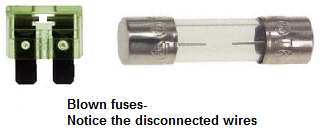How Fuses Work

Fuses are protective devices that will break or melt in the event that excess current enters into a circuit. This functions as protection so that the excess current doesn't get into the sensitive electronics and destroys components.
A good-working fuse is continuous. This means the fuse has continuity from one end to the other. When a circuit is functioning within the tolerable current and power ratings, the fuse remains good and intact.
However, if the current exceeds a certain level, the fuse is designed to have a specific melting point only to withstand a certain amount of current. For example, there are fuses with different current tolerance levels, to handle different levels of current. Some fuses will melt at 3 amperes of current. Others at 4. Thus, different fuses have different meltdowns, based on what is needed for the circuit at hand.

If the current levels coming into the circuit exceeds the level that the fuse was made to handle, the connector in the fuse will melt. This will create a break in the fuse so that the excess current cannot go across into the rest of the circuit, where sensitive electronic components may be located. If no fuse was in the circuit, there would be no break made, so that the excess current would reach and destroy the whole electronic circuitry. The fuse really is a circuit saver.
When a fuse gets destroyed due to excess current, the electronic device will no longer work because
the fuse acts as an open circuit, not allowing any of the excess, damaging current to enter through. The way to
allow the circuit to function again is to replace the broken fuse with a good fuse.
Related Resources
How to Test a Fuse
What is a Slow-blow Fuse?
How to Build an Overvoltage Protection Circuit